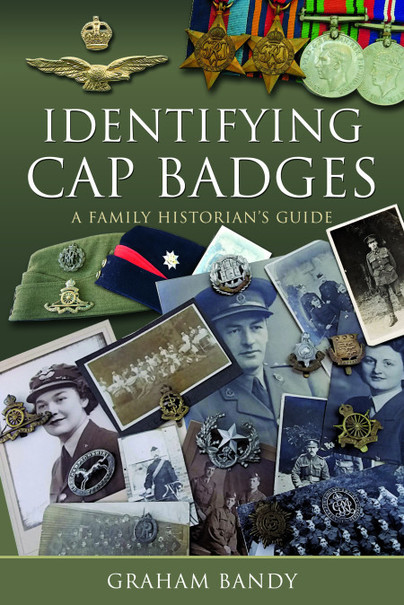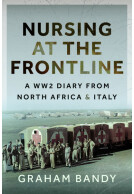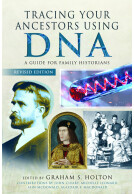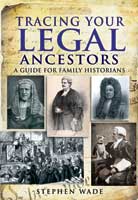Identifying Cap Badges (Hardback)
A Family Historian's Guide
Imprint: Pen & Sword Family History
Pages: 328
Illustrations: 1,290 black and white illustrations
ISBN: 9781526775979
Published: 27th January 2022
(click here for international delivery rates)
Order within the next 47 minutes to get your order processed the next working day!
Need a currency converter? Check XE.com for live rates
| Other formats available - Buy the Hardback and get the eBook for £1.99! | Price |
|---|---|
| Identifying Cap Badges ePub (399.0 MB) Add to Basket | £6.99 |
This book is an invaluable ‘tool of the trade’ for anyone trying to identify or interpret photos. – Peter Hart, Military Historian
This fascinating and impressively-researched volume will become an invaluable resource for all on a quest to find out about family members who served as well as those who have a fascination with the details of British military history. - Col. Richard Kemp CBE former military head of COBR and commander British Forces, Afghanistan
Identifying Cap Badges is the book that has been missing from the bookshelves of family historians, military enthusiasts, and badge collectors alike.
It is quite easy to find an erudite book on military cap badges, but you could spend hours, if not days, plodding through hundreds of pictures to find a match for the one you hold. Sometimes you may not find it at all!
These learned badge collector's books have one major flaw; they are pictured and discussed in 'order of precedence', that is to say, from the earliest formed regiments to the latest, with separate sections on medical, engineers, cavalry, infantry, etc. This can be most confusing to those uninitiated into the 'dark arts' of military badges. Thus, if you do not know the name or 'original number' of your regiment in this order of precedence, you can be flummoxed! This, combined with all the different crowns, laurels, animals, mythological beasts and castles, can prove more than a little daunting, even to ex soldiers themselves!
In this book you will find badges ordered by what is on the badge itself; be it a dragon, sphinx or castle, horse, lion or tiger. This is badge identification in minutes, rather than hours, with added information on dating badges and many comparison photographs alongside all the pictures of the badges. Added to these pictures are short histories of the regiments and 'family trees' plotting the antecedents of today's units.
An excellent source of information for anyone interested in the history of the badges of the British Armed Forces.
IPMS/USA
Read full review here
This is thoroughly practical book has been aimed at the family historian, when faced with a family photograph or a cap badge handed down through the family, but who is now perplexed as to how to identify it. As Graham explains at the start – there are a lot of books on cap badges out there, but most of them are organised in Order of Precedence, meaning that you pretty much need to know the answer you’re seeking in order to use those books. However, with his book he’s arranged the chapters by ‘what you see’. E.g. with a chapter on lions and another on birds and so forth. Thus, if you have an ancestor’s cap badge with a lion on it, go to the chapter on lions to find out more.
Family Tree magazine
Aside from the cap badge information Graham has provided: a really useful succinct summary of the organisation of British Army regiments; explanations of the regular Army, volunteers, yeomanry; coverage of battle honours and the history and meanings/origins of the cap badges; and an overview of the changes of uniform including headdress over time. Graham, does touch too on the Royal Navy, the iterations of the Air Force, QAIMNS, Home Guard, SWBs, and munitionettes etc – so the books covers a wide range of the sorts of badges that family historians may frequently come across.
His book is a mine of quirky military info. A clear overview and packed with juicy nuggets to delight cap badge and military family history fans.
"Graham Bandy has taken a highly specialised subject and produced a very readable book enlivened with extensive anecdotal material and photographs. It is certainly a work I would recommend to the family historian as a go-to source of information on ancestors with a military involvement."
Glasgow and West of Scotland FHS
"This book is fully illustrated and a valuable refence guide compiled by the expert knowledge of an ex-soldier containing chapters on Birds and Wings, Bugle Horns, Castles, Circles and Ovals, Coats of Arms, Crosses, Dragons, Feathers, Flowers and Plants, Grenades and Flames, Guns, Lions, Harps and so on. I never served in the armed forces but I found this book entrancing."
Ian White, Cumbria FHS - Cumbria Newsletter and Lancashire Journal
"This book is easy to follow, is profusely illustrated and the appendices contain lists of historic cavalry and infantry regiments with their names and changes, regimental and service numbers, and lost units".
Journal of the Bristol & Avon Family History Society - June 2022 - Number 188
"In this book you will find badges ordered by what is on the badge itself, be it a dragon, sphinx or castle, horse, lion or tiger. This is badge identification in minutes, with added information on dating badges and many comparison photographs alongside all the pictures of the badges."
Root & Branch, West Surrey Family History Society, Volume 49 No 1 June 2022
As Featured In
The Yorkshire Reporter, May 2022
A fantastic work of reference into the cap badges of the British Army, with a wealth of illustrations. The work is well researched and expertly presented.
Clwyd FHS
If you have photographs of an ancestor in uniform showing his Cap Badge I am sure that this will help you identify the Regiment.
Recommended.
Book review as featured in
Shropshire Star
Review as featured in
Who Do You Think You Are
Highlight: '...would absolutely be a useful addition to the library of a family history group or a local library.'
"A great reference book for those who want to do their own military sleuthing and one I will recommend people use."
Oxfordshire Family History Society Newsletter, Volume 36, No.1, April 2022
As featured in
The Armourer
"A useful addition to the library of a family history group or a local library."
WDYTYA Magazine
Overall, while this fine publication is likely to be of most interest to those specialising in military research, it has much to offer to hobbyist and professional genealogists looking for valuable clues about the service of their Army ancestors. It comes highly recommended.
Alde Valley Suffolk Family History Group
Book review 'For Historians and Collectors' as featured in
St Austell Voice
Book review 'For Historians and Collectors' as featured in
Newquay Voice
I did not think I really needed this book!... But I bought it out of curiosity and on the off-chance that I might learn something new, shortly after starting it I cursed that this book wasn't available 25 years ago, it would have helped a hundred times over during that time.
Customer Review
Ordered in a manner that the complete novice, amateur historian or long term researcher can understand, this research tool should be in the bookcase of everyone with even a basic interest in British army units of the 20th Century!
Much enjoyed and I'm sure it will be useful for decades to come!
I think we've all got photos of servicemen who we can't identify – or, even if we know who they are, can't work out which regiment they served in.
Lost Cousins
Identifying Cap Badges – a family historian's guide offers us a chance to answer some of those difficult questions. As the author points out, other books on this topic are arranged in 'order of precedence', with the regiments that were formed earliest at the beginning – but that's not much use to the layman whose only clue is the design of the badge.
Accordingly the photos in the book are organised thematically and alphabetically, starting in Chapter 2 with designs that feature 'birds and wings', followed by 'bugle horns', 'castles', 'circles and ovals' and eventually reaching 'wreaths' in Chapter 31. Some badges appear under more than one heading, for example the Duke of Lancaster's Own Yeomanry wear a badge that incorporates both a rose and a wreath, so it is found in Chapter 12 ('flowers and plants') as well as Chapter 31.
By and large it's a reference book, one to refer to when needed, but there is a section which explains the history of badges in the British Army, whilst Chapter 1 provides an extensive introduction, including tips to help with dating badges. I should mention that it includes a section on women's services – including the Women's Land Army – and I also noticed some munition workers badges.
Whilst I haven’t attempted to count them, there must be well over 1000 photographs in this 320-page book.
As featured in
Family Tree
As featured in
South Wales Echo (Cardiff)
This book to is a fantastic and very informed book. A brilliant book that would be a valuable resource for family historians to help trace and identify ancestors. As well as a huge amount of photographs, the supporting text is also in-depth and very informative, certainly an all-around book I would happily recommend especially those that love to find out family history information.
UK Historian
Read the full review here
An invaluable resource for all on a quest to find out about family members who served as well as those who have a fascination with the details of British military history. From the earliest formed regiments to the latest, with separate sections on medical, engineers, cavalry, infantry, etc.
NetGalley, C M
A lot of family historians will have ancestors who fought in the 1914-1918 conflict and also have members of their family who took part in the 2nd World War. This book looks at Cap Badges of the Army over the centuries.
East Yorkshire Family History Society
Although some of our photo albums contain images which vary in the quality of the pictures between the covers it can be an easy or difficult process to identify the badges that are shown on the caps. Graham Bamdy tries to offer his assistance to the family historian who would like to know which Regt the ancestor was serving in at the time of the global conflicts.
There is a useful intro about “How to use this book” where the author suggests – look for what you can see- Does it have a crown on top of it? Can you see wings, or something else? When you have identified the main features in the pictures use the contents list to find the appropriate section.
A tip to use and remember is to try to get a good quality picture, scan it and use a magnifying glass in conjunction with this guide.
Good luck identifying your military ancestors Regt.
As a very amateur collector, this is a great reference source. Looking at the shape of the badge before the name, making it brilliantly easier to identify. Detailed photographs, easy to read, and great value for money. Great if your beginning or for the more experienced collectors.
Virginia Smith
In short, the author has produced a book that makes identifying a unit from a cap badge so much easier than previously possible. This volume will therefore appeal to military historians and the general public alike. It will save man-hours of difficult research comparing pages of cap badges against those in period images. On this note, a large “thank you” must go to the author as this book will be of great benefit to so many people.
Dr Stuart C Blank, Military Archive Research
A fabulous book for anyone trying find out more about military history from a photograph. But it's so much more than just cap badges. Detailed photos and research guidance on uniforms,headdress and webbing etc.
User Review
Perfect for anyone who thinks they know something and those who equally know little to nothing! Fully recommend.
I was pleased to receive this book as gift from my son. As someone who has dabbled in military history for many years it is a mine of information. It is particularly useful as it photos of many badges. I am not far into the book yet. Congratulations on producing a reference book of this quality.
Allan Young
This book has been needed for those that look at family photos, of faces from the past in uniforms . The regiments of which they have served in my not be known but now can be be found and researched . A tool that opens up a vast array of questions to give the reader a hunger to search for more answers . The book is easy to read and use . A very large collection of photos to enjoy. The information is delivered in a size to make it concise and enjoyable . Makes the reader wish to delve further . The book also tells you where to go next in that hunt . I hope there will be more from author , as this book has wetted the appetite. So much in this book makes it a must . Get your copy now !!
User Review
This book is an invaluable 'tool of the trade' for anyone trying to identify or interpret photos.
Peter Hart, Military Historian
This is a great book to add to the bookstore of genealogist both professional and amateur a like. I found it very informative myself.
NetGalley, Carissa Miller
A brilliant book and such a useful resource for family historians.
Barry Miller
Like many other family historians I come across photos of ancestors in uniform with very little information on them other than perhaps a name. Until now it has taken quite some detective work to find out which regiment the soldier actually served in. This is even more difficult for WW1 ancestors because, as Graham Bandy says, only about one in three service records records survived an incendiary attack on London in 1940. This book makes the process of identifying which record the soldier was in so much easier because of the way the book is designed to be used.
The introduction and forward chapters are fascinating and are a must to read as the author explains a lot about the history of badges.
A fantastic resource for family/military historians. Highly recommended.
Michael Lee
There are actually 1290 photographs in this book!
Graham Bandy
It has been described by the noted Great War author Peter Hart as"bloody useful"
This is a labour of love that easily finds the badge you are trying to match. Totally different, and an adjunct to the learned tomes such as Gaylor and Kipling and King.
About Graham Bandy
Graham Bandy has spent most of his life in the army, nursing, or both. He has been identifying military badges since he was at school, and is now a much sought after asset at both county and national family history fairs, such as WDYTYA Live and Family Tree Live and has also appeared on BBC's WDYTYA. Graham also gives many talks and lectures on the subject of badge and photographic identification and sits on the Heritage Committee of the QARANC Association. He is married and lives in Sussex with his wife and an ever growing collection of militaria and military photographs, under which they are both slowly drowning.
















